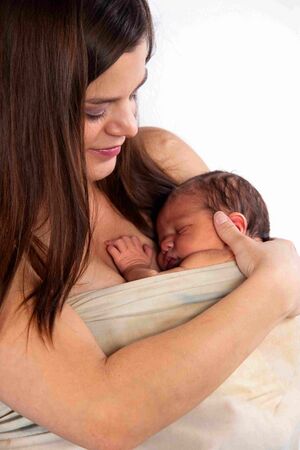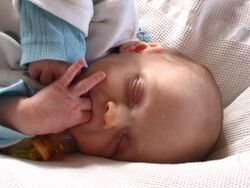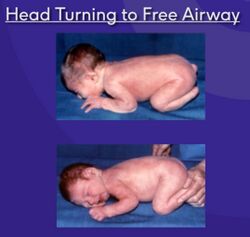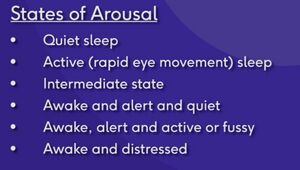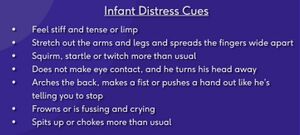Understanding Newborn Behaviour: Difference between revisions
(Added a video) |
(temperament changes) |
||
| Line 45: | Line 45: | ||
== Arousal, Crying and Colic == | == Arousal, Crying and Colic == | ||
=== Neonatal | === Neonatal Behavioural Assessment Scale === | ||
Pam Versfeld refers to this assessment scale throughout her course on Newborn Infant Behaviour. Dr T Berry Brazelton along with colleagues at Harvard University has studied infant behaviour over many decades and developed the widely used Neonatal Behavioral Assessment Scale (NBAS).<ref name=":7">Brazelton TB, Nugent JK. [http://nidcap.org/wp-content/uploads/2013/12/Brazelton-1973-BNBAS.pdf Neonatal behavioral assessment scale]. Cambridge University Press; 1995 Jan 17.</ref> | Pam Versfeld refers to this assessment scale throughout her course on Newborn Infant Behaviour. Dr T Berry Brazelton along with colleagues at Harvard University has studied infant behaviour over many decades and developed the widely used Neonatal Behavioral Assessment Scale (NBAS).<ref name=":7">Brazelton TB, Nugent JK. [http://nidcap.org/wp-content/uploads/2013/12/Brazelton-1973-BNBAS.pdf Neonatal behavioral assessment scale]. Cambridge University Press; 1995 Jan 17.</ref> | ||
| Line 64: | Line 64: | ||
=== Arousal === | === Arousal === | ||
[[File:States of arousal.jpg|right|frameless]] | [[File:States of arousal.jpg|right|frameless]] | ||
Dr. | Throughout the day, an infant will cycle through several stages of arousal, some quick, others slow. American paediatrician Dr T.B. Brazelton identified six states of infant behaviour. Dr. Brazelton, described six states of arousal in newborn infants. <ref name=":7" /> | ||
There are 2 sleep states, and one intermediate state and 3 awake states:<ref name=":7 | There are 2 sleep states, and one intermediate state and 3 awake states:<ref name=":7" /> | ||
'''Sleep states:''' | '''Sleep states:''' | ||
# Quiet Sleep - In this protected state the infant is able to cut out disturbing stimuli from the environment. | # Quiet Sleep - In this protected state the infant is able to cut out disturbing stimuli like noise from the environment.<ref name=":0" /> | ||
# Active Sleep (REM) - The infant’s breathing is shallower and irregular with sucking and writhing movement occurring from periodically. Outside influences might disturb the infant more in this state. When roused the infant will either waken sleepily and fussy, or struggles to sink back into deep sleep. | # Active Sleep / Rapid Eye Movement (REM) - The infant’s breathing is shallower and irregular with sucking and writhing movement occurring from periodically. Outside influences might disturb the infant more in this state. When roused the infant will either waken sleepily and fussy, or struggles to sink back into deep sleep.<ref name=":0" /> Rotating or fluttering of the eyes, shallow breathing, more receptive to outside noise.<ref name=":3">Healthchildren.org. States of Consciousness in Newborns. Available from:https://www.healthychildren.org/English/ages-stages/baby/Pages/States-of-Consciousness-in-Newborns.aspx 11/2/2009</ref> | ||
'''Indeterminate state:''' | '''Indeterminate state:''' | ||
This short-lived state occurs frequently when the infant rouses or returns to sleep. The infant squirms and moves jerkily, opens and closes the eyes again, and may whimper or cry out. The infants appear disorganised as they try to fall back to sleep or wake up. | State between alertness and sleepiness.<ref name=":3" /> This short-lived state occurs frequently when the infant rouses or returns to sleep. The infant squirms and moves jerkily, opens and closes the eyes again, and may whimper or cry out. The infants appear disorganised as they try to fall back to sleep or wake up.<ref name=":0" /> Light stimulation, such as rocking them, can help ease them into sleep or slowly wake them up.<ref name=":3" /> | ||
'''Awake states:''' | '''Awake states:''' | ||
When awake infants shift between 3 different states which affect the organisation of their spontaneous movements and looking and listening behavior | When awake infants shift between 3 different states which affect the organisation of their spontaneous movements and looking and listening behavior<ref name=":0" /> | ||
# Alert but quiet state - movement is minimal. Often associated with visual attention to the infant's own hand or the face of a social partner and other interesting visual stimuli in the environment. | # Alert but quiet state - movement is minimal. Often associated with visual attention to the infant's own hand or the face of a social partner and other interesting visual stimuli in the environment.<ref name=":0" /> Ideal time for learning. They are happy, peaceful, and focused. Ready for stimulation and interaction.<ref name=":3" /> | ||
# Alert and active state - infants engage in bouts of vigorous spontaneous movements of the limbs. | # Alert and active state - infants engage in bouts of vigorous spontaneous movements of the limbs.<ref name=":0" /> Stretching, kicking, and rotating arms. | ||
# Awake and distressed state - the infant's movements are ongoing and very vigorous. Jitters and trembling may be present in the limbs. Parents and caregivers will usually move in to calm the infant. | # Awake and distressed state - the infant's movements are ongoing and very vigorous. Jitters and trembling may be present in the limbs. Parents and caregivers will usually move in to calm the infant.<ref name=":0" /> | ||
{{#ev:youtube|7NnRyq3xr1A |300}}<ref>mnhealth. 16 - Baby Behavior: All about sleep. Available from: https://youtu.be/7NnRyq3xr1A [last accessed 13/5/2022]</ref> | {{#ev:youtube|7NnRyq3xr1A |300}}<ref>mnhealth. 16 - Baby Behavior: All about sleep. Available from: https://youtu.be/7NnRyq3xr1A [last accessed 13/5/2022]</ref> | ||
=== Colic === | |||
== | * All healthy, young babies cry and fuss–sometimes inconsolably, and frequently without any obvious cause. This is more common in the late afternoon and evening. | ||
* Excessive infant crying is known as 'colic' and previously blamed on indigestion pain. | |||
* Babies cry a lot during the first 6 weeks after birth. <ref>Wolke, D., Bilgin, A., & Samara, M. (2017). [https://eprints.kingston.ac.uk/id/eprint/37811/1/Samara-37811-AAM.pdf Systematic Review and Meta-Analysis: Fussing and Crying Durations and Prevalence of Colic in Infants.] The Journal of pediatrics, 185, 55–61.e4. <nowiki>https://doi.org/10.1016/j.jpeds.2017.02.020</nowiki></ref> | |||
* The amount of infant crying during the first three months is associated with the experience of tiredness and fatigue in new mothers.<ref>Kurth, E., Kennedy, H. P., Spichiger, E., Hösli, I., & Stutz, E. Z. (2011). Crying babies, tired mothers: what do we know? A systematic review. Midwifery, 27(2), 187–194. <nowiki>https://doi.org/10.1016/j.midw.2009.05.012</nowiki></ref> | |||
* Crying is a normal discharge of an overloaded nervous system after a busy day. The infant may need to fuss.<ref name=":7" /> | |||
* Picking the infant up every 10-15 minutes, soothing and then putting the infant down again is a good way to deal with this crying.<ref name=":7" /> | |||
== Infant Distress Cues == | |||
[[File:Infant Distress Cues.jpg|center|frameless]] | |||
Parents and caregivers need to learn to recognise their infant’s particular behavioural cues. At the same time they are learning how to respond in a way that satisfies the infant’s needs. These different ways of responding are dictated by the infant’s temperament. | |||
=== Infant Temperament === | |||
Newborn temperament describes the way in which babies respond and react to stimulation. Their emotions and reactions are a result of nature (innate personality) and nurture (parenting style). Researchers Thomas and Chess reported that when a child's personality is well suited to their environment, they will do better than children whose personalities and environments fit together poorly.<ref name=":5">McClowry SG, Rodriguez ET, Koslowitz R. [https://www.ncbi.nlm.nih.gov/pmc/articles/PMC2846651/ Temperament-based intervention: Re-examining goodness of fit]. International Journal of Developmental Science. 2008 Jan 1;2(1-2):120-35.</ref> Temperament in infancy is generally defined as constitutionally based biological individual differences in attentional, motor, and emotional reactivity and self-regulation that are exhibited in different contexts in response to stimulation.<ref>Bornstein, M. H., Putnick, D. L., Gartstein, M. A., Hahn, C. S., Auestad, N., & O'Connor, D. L. (2015). [https://www.ncbi.nlm.nih.gov/pmc/articles/PMC4428977/ Infant temperament: stability by age, gender, birth order, term status, and socioeconomic status]. Child development, 86(3), 844–863. </ref> Temperament traits can be grouped into the following nine categories:<ref name=":8">SickKids. [https://www.aboutkidshealth.ca/Article?contentid=499&language=English# Temperament.] About Kids Health. 2009.</ref> | |||
== | |||
*[[File:Babytemperment.jpeg|thumb|400x400px|Baby temperament]]Activity level: how active the infant is | |||
* Rhythmicity: how regular the infant’s sleep/wake and feeding routines are | * Rhythmicity: how regular the infant’s sleep/wake and feeding routines are | ||
* Distractibility: how easily the infant can be distracted from something they are doing | * Distractibility: how easily the infant can be distracted from something they are doing | ||
* Approach/withdrawal: how the infant responds to new experiences | * Approach/withdrawal: how the infant responds to new experiences | ||
* Adaptability: how the infant adapts to new situations | * Adaptability: how the infant adapts to new situations | ||
* Attention span/persistence: how persistent the infant is when faced with challenges | * Attention span/persistence: how persistent the infant is when faced with challenges | ||
* Intensity of reaction: how intense the infant’s responses and emotions are | * Intensity of reaction: how intense the infant’s responses and emotions are | ||
* Sensitivity: how sensitive the infant is to flavours, textures, and noises | * Sensitivity: how sensitive the infant is to flavours, textures, and noises | ||
* Quality of mood: whether the infant has a happy, positive mood most of the time or an unpleasant, negative mood most of the time <ref name=": | * Quality of mood: whether the infant has a happy, positive mood most of the time or an unpleasant, negative mood most of the time <ref name=":8" /> | ||
Some children are born with a more cautious temperament, they respond with weariness to new people and situations. They are slow to warm up, easily distressed and when upset take longer to recover. <ref name=":9">Skills for Action. [https://skillsforaction.com/highly-sensitive-child The highly sensitive child and behavioral inhibition].</ref> | |||
Highly sensitive, cautious/fearful infants may be fussy, react strongly to any changes such as being undressed. They can be difficult to calm and may react strongly to strangers or unfamiliar situations. <ref name=":9" /> | |||
* | |||
{{#ev:vimeo|273460457}}<ref name=":4">RaisingChildren.net.au. Baby Cues and Baby Body Language: A Guide. Available from:https://raisingchildren.net.au/newborns/connecting-communicating/communicating/baby-cues 8/20/20</ref> | |||
# | {{#ev:vimeo|273460014}}<ref name=":4" /> | ||
* | |||
{{#ev:vimeo|273460899}}<ref name=":4" /> | |||
* | |||
{{#ev:vimeo|273459822}}<ref name=":4" /> | |||
== Resources == | == Resources == | ||
Revision as of 01:43, 14 May 2022
Top Contributors - Robin Tacchetti, Robin Leigh Tacchetti, Tarina van der Stockt, Ewa Jaraczewska, Kim Jackson, Jess Bell and Tony Lowe
Introduction[edit | edit source]
Newborns are born with an innate capacity to interact with their environment.[1] Instinctive cognitive and sensorimotor behaviour contribute to survival and social bonding.[2] Infants naturally find ways to use touch, manage arousal levels, self-soothe and adapt to their new physical environment. In addition to adaptation, they signal their needs with different cries and temperaments.[1]
Adapting to the Environment[edit | edit source]
One of the most effective ways for an infant to adapt to their environment is through skin-to-skin (SSC) contact. The baby dressed in a diaper is placed on the mother’s bare chest so that frontal body contact is skin-to-skin. (baby on their mother’s chest).[3] UNICEF outlines the many benefits for mother-infant skin-to-skin contact:[4]
- Calms and relaxes both mother and infant
- Regulates the infant’s heart rate and breathing, helping them to better adapt to life outside the womb
- Stimulates digestion and interest in feeding
- Regulates temperature
- Enables colonisation of the infant’s skin with the mother’s friendly bacteria, thus providing protection against infection
- Stimulates the release of hormones to support breastfeeding and mothering[4]
Research shows skin-to-skin contact may have secondary benefits for the mother in terms of her long-term mental health, in addition to its positive impact on infant development. [5][6]
Three Newborn Survival Behaviours Which Build on Foetal Action Patterns[edit | edit source]
These newborn survival behaviours include rooting, the suck-swallow-breathe synergy, and turning the head to free the airway.[1] These movement behaviours are organised as perceptual-motor synergies (also referred to as motor patterns) which can be adapted to changing circumstances and events in the environment.[1] Previously these synergies were described as reflexes, but more recent studies have shown that these synergies involve complex patterns of movements adapted to ongoing changes in the environment. [2][1]
Rooting[edit | edit source]
- Rooting refers to the infant's tendency to turn their head towards a touch stimulus, applied to the area around the mouth which facilitates turning towards and latching onto the nipple for feeding.
- Traditionally rooting was considered to be a stereotype response to a specific stimulus in other words, it was thought to be a simple reflex. But research has shown that the rooting response adapts to circumstances, for instance, rooting is not elicited when babies or infants touch themselves. [1]
- The motion of the infant's head and mouth occurs simultaneously with whole-body movements suggesting rooting is more than a reflex.[2][7]
Sucking[edit | edit source]
- Sucking is another newborn behaviour that involves a complex interaction of muscle contractions that are adaptable to the environment. Babies adjust sucking pressure based on the flow of milk by sensing the upcoming flow. Studies show that newborns adjust the sucking pressure in a precise and anticipatory way demonstrating action vs reflex.[2] “Craig and Lee (1999) found that neonates adjusted their sucking action in a precise and prospective way indicating that they anticipated the upcoming flow of milk.” [2]
- Sucking has two phases
- creating a temporary vacuum in the mouth region
- releasing the milk from the nipple[8]
- Sucking adaptation can also be seen when newborns suck for comfort instead of food.[9]
Head turning to keep airway clear[edit | edit source]
- The ability to lift and turn head to keep airway clear is another perceptual-motor synergy present from birth. [1]
- When placed face-down on a supporting surface newborn infants will lift and turn their heads to clear the airway. [1]
- Lifting and turning the head involves not only the neck muscles, but also requires some adjustments in the upper extremities and trunk muscles to provide some stability to support the neck movements.[8]
Arousal, Crying and Colic[edit | edit source]
Neonatal Behavioural Assessment Scale[edit | edit source]
Pam Versfeld refers to this assessment scale throughout her course on Newborn Infant Behaviour. Dr T Berry Brazelton along with colleagues at Harvard University has studied infant behaviour over many decades and developed the widely used Neonatal Behavioral Assessment Scale (NBAS).[10]
You can read more about it here by following these links:
Or you can watch these short videos to get a better understanding. The third video shows the full NBAS exam. It is in French, but even if you do not understand French, the demonstration gives you a good overview of the full exam.
Arousal[edit | edit source]
Throughout the day, an infant will cycle through several stages of arousal, some quick, others slow. American paediatrician Dr T.B. Brazelton identified six states of infant behaviour. Dr. Brazelton, described six states of arousal in newborn infants. [10]
There are 2 sleep states, and one intermediate state and 3 awake states:[10]
Sleep states:
- Quiet Sleep - In this protected state the infant is able to cut out disturbing stimuli like noise from the environment.[1]
- Active Sleep / Rapid Eye Movement (REM) - The infant’s breathing is shallower and irregular with sucking and writhing movement occurring from periodically. Outside influences might disturb the infant more in this state. When roused the infant will either waken sleepily and fussy, or struggles to sink back into deep sleep.[1] Rotating or fluttering of the eyes, shallow breathing, more receptive to outside noise.[14]
Indeterminate state:
State between alertness and sleepiness.[14] This short-lived state occurs frequently when the infant rouses or returns to sleep. The infant squirms and moves jerkily, opens and closes the eyes again, and may whimper or cry out. The infants appear disorganised as they try to fall back to sleep or wake up.[1] Light stimulation, such as rocking them, can help ease them into sleep or slowly wake them up.[14]
Awake states:
When awake infants shift between 3 different states which affect the organisation of their spontaneous movements and looking and listening behavior[1]
- Alert but quiet state - movement is minimal. Often associated with visual attention to the infant's own hand or the face of a social partner and other interesting visual stimuli in the environment.[1] Ideal time for learning. They are happy, peaceful, and focused. Ready for stimulation and interaction.[14]
- Alert and active state - infants engage in bouts of vigorous spontaneous movements of the limbs.[1] Stretching, kicking, and rotating arms.
- Awake and distressed state - the infant's movements are ongoing and very vigorous. Jitters and trembling may be present in the limbs. Parents and caregivers will usually move in to calm the infant.[1]
Colic[edit | edit source]
- All healthy, young babies cry and fuss–sometimes inconsolably, and frequently without any obvious cause. This is more common in the late afternoon and evening.
- Excessive infant crying is known as 'colic' and previously blamed on indigestion pain.
- Babies cry a lot during the first 6 weeks after birth. [16]
- The amount of infant crying during the first three months is associated with the experience of tiredness and fatigue in new mothers.[17]
- Crying is a normal discharge of an overloaded nervous system after a busy day. The infant may need to fuss.[10]
- Picking the infant up every 10-15 minutes, soothing and then putting the infant down again is a good way to deal with this crying.[10]
Infant Distress Cues[edit | edit source]
Parents and caregivers need to learn to recognise their infant’s particular behavioural cues. At the same time they are learning how to respond in a way that satisfies the infant’s needs. These different ways of responding are dictated by the infant’s temperament.
Infant Temperament[edit | edit source]
Newborn temperament describes the way in which babies respond and react to stimulation. Their emotions and reactions are a result of nature (innate personality) and nurture (parenting style). Researchers Thomas and Chess reported that when a child's personality is well suited to their environment, they will do better than children whose personalities and environments fit together poorly.[18] Temperament in infancy is generally defined as constitutionally based biological individual differences in attentional, motor, and emotional reactivity and self-regulation that are exhibited in different contexts in response to stimulation.[19] Temperament traits can be grouped into the following nine categories:[20]
- Activity level: how active the infant is
- Rhythmicity: how regular the infant’s sleep/wake and feeding routines are
- Distractibility: how easily the infant can be distracted from something they are doing
- Approach/withdrawal: how the infant responds to new experiences
- Adaptability: how the infant adapts to new situations
- Attention span/persistence: how persistent the infant is when faced with challenges
- Intensity of reaction: how intense the infant’s responses and emotions are
- Sensitivity: how sensitive the infant is to flavours, textures, and noises
- Quality of mood: whether the infant has a happy, positive mood most of the time or an unpleasant, negative mood most of the time [20]
Some children are born with a more cautious temperament, they respond with weariness to new people and situations. They are slow to warm up, easily distressed and when upset take longer to recover. [21]
Highly sensitive, cautious/fearful infants may be fussy, react strongly to any changes such as being undressed. They can be difficult to calm and may react strongly to strangers or unfamiliar situations. [21]
Resources[edit | edit source]
- Brazelton Institute | Neonatal Behavioral Assessment Scale (NBAS)
- Brazelton Institute at Boston Children’s Hospital
- RaisingChildren | Baby cues and baby body language: a guide
- UNICEF | Skin-to-skin contact
References[edit | edit source]
- ↑ 1.00 1.01 1.02 1.03 1.04 1.05 1.06 1.07 1.08 1.09 1.10 1.11 1.12 1.13 1.14 Versfeld, P. Understanding Newborn Behaviour, Physioplus.2022
- ↑ 2.0 2.1 2.2 2.3 2.4 Von Hofsten C, Rosander K. The development of sensorimotor intelligence in infants. Advances in child development and behavior. 2018 Jan 1;55:73-106.
- ↑ Cleveland L, Hill CM, Pulse WS, DiCioccio HC, Field T, White-Traut R. Systematic review of skin-to-skin care for full-term, healthy newborns. Journal of Obstetric, Gynecologic & Neonatal Nursing. 2017 Nov 1;46(6):857-69.
- ↑ 4.0 4.1 Center for Perinatal Psychology. Six States of Alertness for Newborns. Available from:https://www.unicef.org.uk/babyfriendly/baby-friendly-resources/implementing-standards-resources/skin-to-skin-contact/ (March 28, 2016)
- ↑ Bigelow AE, Power M. Mother–Infant Skin-to-Skin Contact: Short‐and Long-Term Effects for Mothers and Their Children Born Full-Term. Frontiers in Psychology. 2020;11
- ↑ Cooijmans KH, Beijers R, Rovers AC, de Weerth C. Effectiveness of skin-to-skin contact versus care-as-usual in mothers and their full-term infants: study protocol for a parallel-group randomized controlled trial. BMC pediatrics. 2017 Dec;17(1):1-6.
- ↑ Rochat P, Hespos SJ. Differential rooting response by neonates: Evidence for an early sense of self. Infant and Child Development. 1997 Sep 1;6(3‐4):105-12.
- ↑ 8.0 8.1 Versfeld, P. SfA Infant Perceptual Motor Development.
- ↑ Lau C. Development of suck and swallow mechanisms in infants. Annals of Nutrition and Metabolism. 2015;66(Suppl. 5):7-14.
- ↑ 10.0 10.1 10.2 10.3 10.4 Brazelton TB, Nugent JK. Neonatal behavioral assessment scale. Cambridge University Press; 1995 Jan 17.
- ↑ Treeincement.The Brazelton Neonatal Assessment. Available from: https://youtu.be/tqc8gKuXs3s [last accessed 13/05/2022]
- ↑ FWIChannel. Brazelton Presentation. Available from: https://youtu.be/ZisX_F6HAfE [last accessed 13/05/2022]
- ↑ Les petits princes de l'éveil .Elisebenazet. Petit aperçu d'une échelle de Brazelton - Elise Bénazet. Available from: https://youtu.be/9GnUt1XJ0vs [last accessed 13/05/2022]
- ↑ 14.0 14.1 14.2 14.3 Healthchildren.org. States of Consciousness in Newborns. Available from:https://www.healthychildren.org/English/ages-stages/baby/Pages/States-of-Consciousness-in-Newborns.aspx 11/2/2009
- ↑ mnhealth. 16 - Baby Behavior: All about sleep. Available from: https://youtu.be/7NnRyq3xr1A [last accessed 13/5/2022]
- ↑ Wolke, D., Bilgin, A., & Samara, M. (2017). Systematic Review and Meta-Analysis: Fussing and Crying Durations and Prevalence of Colic in Infants. The Journal of pediatrics, 185, 55–61.e4. https://doi.org/10.1016/j.jpeds.2017.02.020
- ↑ Kurth, E., Kennedy, H. P., Spichiger, E., Hösli, I., & Stutz, E. Z. (2011). Crying babies, tired mothers: what do we know? A systematic review. Midwifery, 27(2), 187–194. https://doi.org/10.1016/j.midw.2009.05.012
- ↑ McClowry SG, Rodriguez ET, Koslowitz R. Temperament-based intervention: Re-examining goodness of fit. International Journal of Developmental Science. 2008 Jan 1;2(1-2):120-35.
- ↑ Bornstein, M. H., Putnick, D. L., Gartstein, M. A., Hahn, C. S., Auestad, N., & O'Connor, D. L. (2015). Infant temperament: stability by age, gender, birth order, term status, and socioeconomic status. Child development, 86(3), 844–863.
- ↑ 20.0 20.1 SickKids. Temperament. About Kids Health. 2009.
- ↑ 21.0 21.1 Skills for Action. The highly sensitive child and behavioral inhibition.
- ↑ 22.0 22.1 22.2 22.3 RaisingChildren.net.au. Baby Cues and Baby Body Language: A Guide. Available from:https://raisingchildren.net.au/newborns/connecting-communicating/communicating/baby-cues 8/20/20
